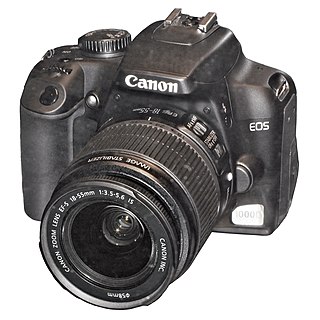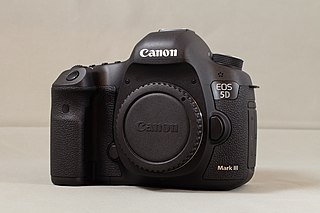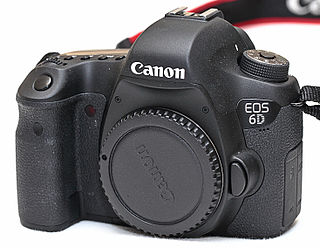
The Canon EOS 20D is an 8.2-megapixel semi-professional digital single-lens reflex camera, initially announced on 19 August 2004 at a recommended retail price of US$1,499. It is the successor of the EOS 10D, and was succeeded by the EOS 30D in August 2006. It accepts EF and EF-S lenses and uses an APS-C sized image sensor.

The EOS-1Ds is a full-frame 11.1-megapixel digital SLR camera body made by Canon in the 1Ds series, released on 24 September 2002. It was Canon's first full-frame DSLR. Its dimensions are 156 x 157.6 x 79.9 mm and mass is 1,265 g.

The EOS 5D is a 12.8 megapixel digital single-lens reflex (DSLR) camera body produced by Canon. The EOS 5D was announced by Canon on 22 August 2005, and at the time was priced above the EOS 20D but below the EOS-1D Mark II and EOS-1Ds Mark II in Canon's EOS digital SLR series. The camera accepts EF lens mount lenses.

The Canon EOS D30 is a discontinued 3.1-megapixel professional digital single lens reflex camera (DSLR) body, initially announced by Canon on May 17, 2000. It is part of the Canon EOS line of cameras and uses the EF lens mount. The EOS D30 was Canon's first "home grown" digital SLR. Before that point Canon had a contract with Kodak to rebrand the Kodak 2-megapixel DCS 520 as Canon EOS D2000 and the 6-megapixel DCS 560 as Canon EOS D6000 digital SLRs, which combined Kodak digital backs and Canon camera bodies.

The Canon EOS D60 is a discontinued 6.3 megapixel digital single lens reflex (DSLR) camera body, announced by Canon on February 22, 2002. It is part of the Canon EOS range, and accepts Canon EF, TS-E and MP-E lenses, but not Canon's later digital-only EF-S lens range.

The EOS 1D Mark III is a professional 10.1 megapixel digital single lens reflex camera (DSLR) camera body produced by Canon. The EOS 1D Mark III was announced on February 21, 2007 and is the successor of the Canon EOS-1D Mark II N and was first released in May 2007. In late 2009, the camera was succeeded by the Canon EOS-1D Mark IV. One of the main benefits of the new Mark III, over the previous models, was the added functionality of Live view, allowing users to take pictures while looking at an LCD screen. While it had the same outdated software as the older 1D series cameras, it had a much improved button layout, which is still used today. It also had improved wireless capabilities over the Mark II. The new WFT-E2 was much smaller than the previous WFT-E1 for the Mark II. The new transmitter could now also connect via a USB port. This allowed the optional addition of a GPS unit and wired PC connectivity.

The Canon EOS 40D is a 10.1-megapixel semi-professional digital single-lens reflex camera. It was initially announced on 20 August 2007 and was released at the end of that month. It is the successor of the Canon EOS 30D, and is succeeded by the EOS 50D. It can accept EF and EF-S lenses. Like its predecessor, it uses an APS-C sized image sensor, resulting in a 1.6x field of view crop factor.

The EOS-1Ds Mark III is a digital SLR camera body by Canon designed for professional photographers. The Canon EOS 1Ds Mark III is successor to the EOS-1Ds Mark II and was announced in August 2007. The camera features a full-frame 21.1 megapixel CMOS sensor with 14-bit analog/digital converters for a total colour depth of 16,384 tones per pixel. It features a three-inch (76 mm) LCD screen, capable of "Live View," and dual DIGIC III processors allowing it to shoot at up to five frames per second.

Canon EOS 1000D is a 10.1-megapixel digital single-lens reflex camera announced by Canon on 10 June 2008 and started shipping in mid August 2008. It is known as the EOS Kiss F in Japan and the EOS Rebel XS in the United States and Canada. The 1000D is an entry-level DSLR that has been described as being a step below the 450D.

The Canon EOS 50D is a 15.1-megapixel digital single-lens reflex camera. It is part of the Canon EOS line of cameras, succeeding the EOS 40D and preceding the EOS 60D.

The Canon EOS 500D is a 15-megapixel entry-level digital single-lens reflex camera, announced by Canon on 25 March 2009. It was released in May 2009. It is known as the EOS Kiss X3 in Japan, and as the EOS Rebel T1i in North America. It continues the Rebel line of mid-range DSLR cameras, is placed by Canon as the next model up from the EOS 450D, and has been superseded by the EOS 550D (T2i).

The Canon EOS 7D is a cropped sensor digital single-lens reflex camera made by Canon. It was announced on 1 September 2009 with a suggested retail price of US$1,699. Among its features are an 18.0 effective megapixel CMOS sensor, HD video recording, its 8.0 frames per second continuous shooting, new viewfinder which offers 1.0X magnification and 100% coverage, 19-point auto-focus system, movie mode, and built-in Speedlite transmitter.

The EOS-1D Mark IV is a professional 16.1 effective megapixels digital single lens reflex camera (DSLR) camera body produced by Canon. The EOS-1D Mark IV is the successor of the Canon EOS-1D Mark III and was announced on 20 October 2009, just four days after Nikon announced the D3s. It is currently the only Canon APS-H format DSLR to feature HD video recording at 1080p resolution.

The Canon EOS 60D is an 18.1 megapixels semi-pro digital single-lens reflex camera made by Canon. It was announced on August 26, 2010, with a suggested retail price of US$1099.00. As a part of the Canon EOS two-digit line, it is the successor of the EOS 50D and is the predecessor of the EOS 70D.

Canon EOS 1100D is a 12.2-megapixel digital single-lens reflex camera announced by Canon on 7 February 2011. It is known as the EOS Kiss X50 in Japan and the EOS Rebel T3 in the Americas. The 1100D is Canon's most basic entry-level DSLR, and introduces movie mode to other entry level DSLRs. It replaced the 1000D and is also the only Canon EOS model currently in production that is not made in Japan but in Taiwan, aside from the EOS Rebel T4i.

The Canon EOS 5D Mark III is a professional-grade 22.3 megapixels full-frame digital single-lens reflex (DSLR) camera made by Canon.

The Canon EOS 6D is a 20.2-megapixel full-frame CMOS digital single-lens reflex camera made by Canon.

The EOS-1Ds is a series of full-frame digital SLR camera bodies made by Canon, first released on 24 September 2002. The series was replaced in March 2012 with the 1D X.

The Canon EOS 7D Mark II is a professional digital single-lens reflex camera made by Canon. It was announced on September 15, 2014 with a suggested retail price of US$1,799. It features a 20.2 effective megapixel APS-C CMOS sensor, Full HD video recording at 60 fps, 10.0 frames per second continuous shooting, a 100% accuracy viewfinder which offers 1× magnification. It also features a 65-point auto-focus system, a built-in Speedlite transmitter and a new 150k RGB pixels + IR metering sensor. It was preceded by the Canon EOS 7D.

In 1989, Canon released a single lens reflex camera, the EOS-1. It utilized new technologies found in the slightly earlier EOS-650, in a professional level body, of which, many of its unique, distinctive characteristics are still found today in more recent versions of its series. Numerous accessories were also available to boost performance and battery life.

























